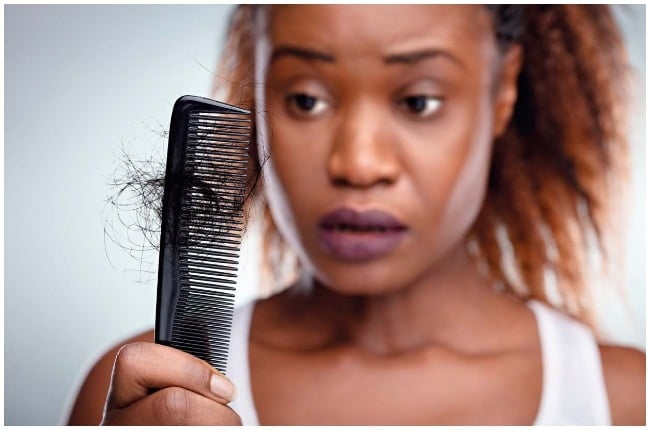
It is strangely comforting for us to know that we are not the only ones suffering from hair loss. Even celebrities are not immune. In the past, former supermodels Naomi Campbell and Tyra Banks, talk show host Wendy Williams and even actress Jada Pinkett Smith, have all openly spoken about the trouble they experienced with their hair.
Luckily for the rest of us, we don’t get even a taste of the public scrutiny and speculation Campbell suffered. She finally broke her silence in 2017 and revealed that she was suffering from a severe case of traction alopecia, caused by years of wearing weaves and tight hairstyles that constantly pulled on the hair follicles. Alopecia – commonly called injibhabha or njipsy – is, according to healthline.com, a condition in which hair is lost from some or all areas of the body.
The complexity of alopecia
Last year, South African actress Gail Mabalane opened up about her hair loss journey after being diagnosed with alopecia. In an Instagram post last March, Mabalane says, “A few months ago, I went to the salon for a routine hair wash. To my shock, after my wash, a big chunk of my hair was gone. Central centrifugal cicatricial alopecia was the diagnosis. Simply put… a very common cause of alopecia or hair loss in black women.”
But, what is the leading source of hair loss in black women? According to Dr Kuda Mupawose, founder of hair brand Feso Africa, “a lack of knowledge and wrong handling of our hair is the biggest cause of hair loss. It’s the things that we are doing to our hair,” she says.
READ MOR | 4 ways to store your wigs to extend their lifespan
She explains further. “Take for example, a relaxer. In five minutes, your hair is already processed, but on the box it says to leave it on for 10–15 minutes. The longer you stay with it, the more you are damaging your hair. This results in hair loss at a later stage.”
This is reiterated by Smangele Sibisi, founder of Indalo Nubian Naturals. Sibisi says DIY treatments often result in too much tension on the scalp. “A lack of knowledge leads us to losing our hair because we don’t know which products to use for our type of hair or the styles to avoid,” she adds.
A breakthrough
While hairstyling contributes to the majority of alopecia cases in black women, recent research by University of KwaZulu-Natal’s Dean of Clinical Medicine, Professor Ncoza Dlova, found that for some, there is also a genetic component.
According to the 2013–2017 breakthrough study for hair loss among black women, central centrifugal cicatricial alopecia (CCCA) is a condition that largely affects women of African descent. CCCA has been reported since the late 1960s and was previously referred to as “hot comb alopecia” because it was related to the use of hot combs for straightening hair.
The study further highlighted that “CCCA is known to be aggravated by trauma-causing treatments that are unhealthy for the hair. This includes chemical treatments and excessive tugging and pulling of the hair that is seen in people who have very tight braids, weaves, extensions and chemically processed hair. When we pull the hair (with or without braids) or attach weaves, we cause mechanical trauma that leads to hair inflammation. After repeated episodes, that leads to permanent hair loss.”
Prof Dlova’s study discovered that CCCA was caused by mutation of a certain type of gene, supposed to code the formation of the hair shaft – meaning the defect in the PADI3 gene causes alteration in the final hair protein defect. The scientific cause of the mutation is unknown, and a cure is not yet available.
Other medical reasons
Other top medical reasons black women lose their hair include an imbalance of thyroid hormones, scalp psoriasis, which is a common skin disorder that makes raised, reddish and often scaly patches, post-natal disorder and trauma resulting in intense stress, to name a few. Sibisi says without earlier abuse, your hair starts thinning from the age of 30.
READ MORE | 5 hair masks to give your dry hair life
Warning signs include excessive shedding, sores and itchiness on the scalp, balding spots and patches on the hairline.
“Young women start experimenting with their hair in their 20s. By the time they hit their 30s, their hairlines are already affected. Hairstyles such as braiding, weaves and chemical procedures – if done too much – may have an impact on your hair journey,” Sibisi says.
Dr Mupawose says that dihydrotestosterone (DHT), a potent form of testosterone that normally leads to hair loss, also becomes active in women in their 30s.
“At that age, the testosterone in women starts to take over, and it sits on the scalp and feeds on hair follicles.” She says black women are more prone to hair loss because they don’t know how to take care of their hair.
“Even the hairdressers don’t know our hair needs. As black people, we were taught how to manipulate our hair to follow a certain norm, and this is the root cause of our hair loss. Even when we seek help, they have no clue of our hair.” Sibisi recommends finding the right stylist to help prevent alopecia. “A professional will be able to advise you on a diet plan and identify changes in your hair colour and texture,” she says.
Dr Mupawose adds that a healthy balanced diet can help to nourish the hair root and combat alopecia. “Taking supplements like iron and calcium can make a difference. Use products that contain DHT blockers and avoid pulling your hair at all times,” she says.
Traction alopecia
This type of alopecia is usually caused directly by your actions, which result in excessive tension on the hair and breakage. Certain hairstyles, such as braiding and tight ponytails, are the most common causes. It can also be caused by repeated treatments with chemicals.
Androgenic alopecia
A genetic condition that affects both men and women. It is recognised by a receding hairline and gradual disappearance of hair from the crown and frontal scalp.
Alopecia areata
A disease that develops when the body attacks its own hair follicles (where hair grows from), which results in hair loss anywhere on the body.
Alopecia totalis
This type occurs when you lose hair on your entire scalp, resulting in complete baldness.
Alopecia universalis
At its most extreme, the hair loss takes place across the entire body, including eyebrows.
Cicatricial alopecia
Also known as scarring alopecia, it occurs when the hair follicles are destroyed and replaced by scar tissue. There are two types of cicatricial alopecia– primary (where the follicle is the target of the inflammation) and secondary (where there is a non-specific cause and the follicle is destroyed indirectly).










